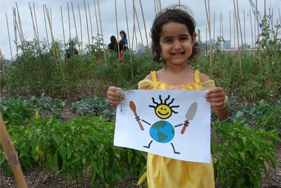World kitchen garden day celebrated in UK

World Kitchen Garden Day celebrates the growing and using of healthy home-grown and local produce on 26th August 2012,
The event is an annual, decentralized celebration of food produced on a human-scale. It is recognized each year on the 4th Sunday of August. It is an opportunity for people around the world to gather in their gardens with friends, family, and members of their local community to celebrate the multiple pleasures and benefits of home-grown, hand-made foods.
KGI initiated Kitchen Garden Day in 2003 as a healthy response to "Snack Food Month" organized by the International Snack Food Association each February. The thinking was that if the makers of potato chips, pretzels and fluorescent orange cheese doodles could spend 28 days and millions of dollars promoting their foods, the world’s kitchen gardeners should be able to have at least a day for celebrating theirs.
Goals:
- To celebrate the positive role of organic kitchen gardening in society, health, and gastronomy
- To raise awareness about the benefits of eating local and to encourage people to explore local food options in their areas
- To build community spirit, at local and international levels, around the universal experiences of gardening, cooking, and eating
In the UK, acclaimed New Forest-based hotel and restaurant The Pig – In the Forest will be marking the event by offering guests a rather special gift.
Anyone dining at The Pig – In the Forest on that day will not only be able to feast on delicious produce grown in the venue’s spectacular kitchen garden, but will be presented with seedlings that can then be transplanted into their own patch at home.
Many hotels boast kitchen gardens, but few are as central to the very heart of the place as the walled wonder at The Pig – In the Forest. The team at The Pig – In the Forest has completely transformed the kitchen garden into an incredible – and edible – haven.
Despite the recent wet weather creating problems such as blight, slugs and flooding, the area now boasts varieties such as strawberries, blueberries, runner beans, beetroot, leeks, broccoli, carrots and a myriad of different types of lettuce and peas. These are grown alongside more exotic specimens including bronze fennel, rainbow chard, mispoona, sea kale and mizuna.
The team also hunts out seeds from plants foraged along the seafront and in the forest, and loves to experiment with new varieties. A recent addition to the Pig – In the Forest’s menu is the pineberry, a white strawberry with red seeds with the flavour and smell of a pineapple.
Today 95% of what is served in the restaurant is either cultivated in the garden, or comes from within a 25-mile radius. Says James, "Almost everything grown in the garden finds its way onto the plates in some form or other, whether roots, shoots, flowers, seed pods, leaves or fruits."
The walled garden at The Pig – In the Forest is now fully cultivated but will continue to evolve over the coming years. "We are in the process of creating an Italian-style tomato tunnel, complete with 14 different varieties, with six types of basil sown in-between," reveals James. "There is always something to be done here. Space may now be at a premium, but that won’t stop us. We will simply extend our planting to areas outside!"
HOW TO CREATE YOUR OWN KITCHEN GARDEN:
THE PIG IN THE FOREST’S TOP TIPS
- When deciding on a location for your kitchen garden, choose a spot that is sheltered from the wind and that gets at least eight hours of sunlight a day. There should also be a water source nearby
- Break up hard, packed soil and add compost. Composted manures or leaves will break down and improve the texture and nutrient content of your soil
- Choose easy-care crops such as lettuce, tomatoes and courgettes that will reap maximum rewards for minimum effort
- If possible avoid crops like potatoes, horseradish or mint as these tend to spread like wildfire
- When planting seedlings, concentrate on the north-south direction of your garden as this is the area that gets maximum exposure to sunlight
- Ensure that any taller trees are away from your seedlings so that they don’t impact on the sunlight
- With vegetables that prefer warmer climates, like tomatoes and peppers, acclimatise them first by keeping them indoors for a few days. Take them out when the temperature gets a bit warmer
- Prepare seedlings beforehand so that you are immediately ready to go with a new crop and beds are not left empty
- Grow different varieties of plants each season to prevent soil borne diseases. Rotate crops so that the soil has a chance to refertilise itself
- If space is at a real premium, don’t despair. Create a mini kitchen garden by interspersing crops in flowerbeds, or by using containers on a patio or balcony
Valere Tjolle
THIS YEAR’S SUSTAINABLE TOURISM MASTERCLASS FOCUSES ON FOOD
 United Kingdom
United Kingdom United States
United States Asia Pacific
Asia Pacific













































Woman dies after getting ‘entangled’ in baggage carousel
Dozens fall ill in P&O Cruises ship outbreak
BA pilot dies during layover
Turkish Airlines flight in emergency landing after pilot dies
Boy falls to death on cruise ship